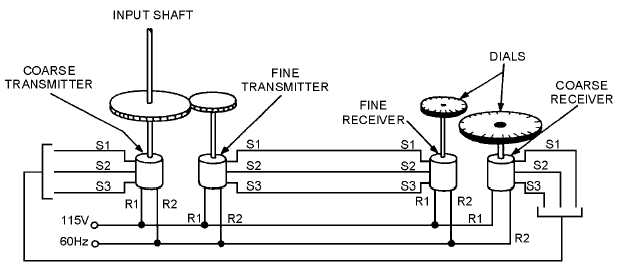1-43
more suitable system. Increasing the speed of a single-speed system from 1-speed to 36-speed provides
greater accuracy, but the self-synchronous feature of the 1-speed system is lost. If primary power is
interrupted in a 36-speed system and the transmitter is turned before power is reapplied, the synchros
could realign themselves in an erroneous position. The number of positions in which the transmitter and
receiver rotors can correspond is the same as the transmission speed. Thus, in the 36-speed system, there
are 35 incorrect positions and only 1 correct position of correspondence.
For accurate transmission of data over a wide range of values without the loss of self-synchronous
operation, multispeed synchro systems must be used. Multispeed synchro systems use more than one
speed of data transmission and, therefore, require more than one output shaft.
DUAL-SPEED SYNCHRO SYSTEM
A basic dual-speed synchro system consists of two transmitters and two receivers, as shown in figure
1-34. One transmitter receives the external input to the system and, through a network of gears, passes the
effects of the external input to the second transmitter. The gear ratio between these two transmitters
determines the two specific speeds the system will use to transmit the input data. The two speeds of this
system are often referred to as fast and slow, high and low, or more often as fine and coarse.
Figure 1-34.—Dual-speed synchro system.
If, for example, the gear ratio between the two transmitters is 36 to 1, 1 revolution of the rotor of the
first transmitter causes 36 revolutions of the rotor of the second transmitter. The first transmitter-the one
that accepts the external input-can be called the coarse transmitter, and the second one can be called the
fine transmitter. Representative speeds include 1 and 36, 2 and 36, and 2 and 72.
The output of each transmitter is passed through standard synchro connections to a receiver. One
receiver receives the coarse signal and the other one receives the fine signal. The two receivers may or
may not be connected by a network of gears similar to the network between the two transmitters. In some
dual-speed applications, a double receiver is used instead of two individual receivers.
The double receiver (fig. 1-35) consists of a coarse and a fine receiver enclosed in a common
housing. It has a two-shaft output one inside the other. The coarse and fine receivers may be likened to
the hour and minute hands of a clock. The coarse receiver corresponds to the hour hand, and the fine



